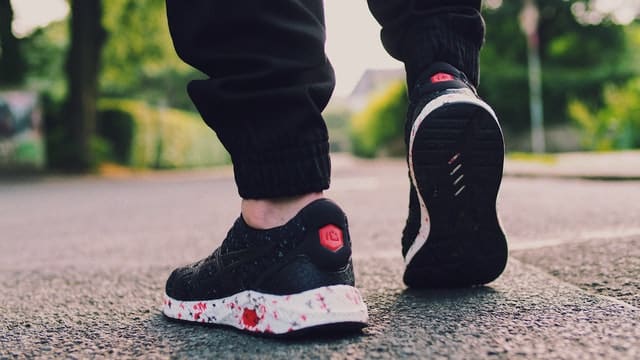Walking is considered a safer physical activity; still, it has a risk of injury. Therefore, to keep up your walking routine, it is better to know how to prevent walking injuries.
The most common injury suffered during walking ranges from strain and pain to more severe conditions like muscle tear and bruises. These injuries are often caused by a worn out pair of shoes, a walking imbalance, or a person’s manner of walking. Usually, older people or those having higher BMI are prone to walking injuries. But anyone can face speed walking injuries that have recently increased walking intensity or duration.
Luckily you can treat walking injuries easily, but if you have prior knowledge on how to prevent walking injuries, then they can be avoided altogether. So here are some of the most common walking injuries and ways to avoid them.
Common Walking Injuries

Walking injuries can be caused due to various reasons, the most common of which is excessive walking. For example, if you walk an hour a day for a month to achieve 10,000 or more steps, you might run into some walking injuries.
The other excessive walking symptoms include feeling tired, not performing as before, feeling depressed, getting injured, and more. Here are some of the most common walking injuries that you need to be aware of.
Shin Splints
Shin splints happen because of the tissue inflammation between leg muscle and shin bone. The tendon helps contract foot muscles and joints during walking.
But a sudden increase in the movements and contractions can stress the muscle and tendon resulting in minor tears. That’s why shin splints are common among beginners and those returning after a more extended period of rest and begin walking long distances.
Shin Splints can be identified when there is a dull pain between your knee and ankle at the front of your foot.
Luckily Shin Splints are curable and is not a severe condition until you stop walking or running. You can treat shin splints by taking a rest from walking or running and applying ice to the affected area. It usually takes around one to six weeks to heal properly.
Knee Pain
Also known as “runners knee”, walking injuries knee is very common due to inflammation from overuse. Sometimes it happens due to the weakness of the quadriceps and hips that cause overpronation and misalignment of the knee cap.
You can diagnose a runners knee if you feel irritation or pain under the kneecap while going uphill or walking up and downstairs.
In most cases, the knee pain goes away by rest and is not very concerning. But if the pain persists and you have trouble walking, immediately see a healthcare provider or a physical therapist.
Plantar Fasciitis
Plantar Fascia is a connective tissue that runs from the heel to the ball of your foot. This area of your foot is under stress with every step, and excessive walking can cause plantar fasciitis.
In addition, anyone with high arches flat feet may lead to planter fascism injury during walking or running. Other causes of Plantar Fasciitis are walking in worn-out shoes, walking on an incline, or your forefoot for a more extended period.
The pain associated with plantar fasciitis is felt under the foot or heel. Taking your first step in the morning or workout can be very painful.
Plantar fasciitis doesn’t require a break from walking or running routine; instead, you must avoid worn-out shoes and keep walking on a flat surface. It would help if you stretched your foot by rolling it on a cold water bottle or a ball for pain relief.
If the pain doesn’t go away, your healthcare provider might advise you to wear a splint to stretch your foot, Achilles tendon, and calf muscle.
Muscle Cramps
The most common reason for muscle cramps is that your muscles aren’t used to exercising, or you’ve strained them over the limit. Muscle cramps are inevitable if you begin walking or running on steep inclines or do any other strenuous physical activity.
Being dehydrated can also cause muscle cramps as the body require lots of electrolytes for any physical activity.
When a muscle cramp happens, you will feel a squeezing pain in your muscles. If this happens, stop and do a few stretches until the cramp goes away.
Stretching your calf muscle before and after a routine walking can also protect you from muscle cramps. On top of that, remember to stay appropriately hydrated while walking or running.
Blisters
Blisters can pop up on your feet when you walk excessively or wear ill-fitted shoes. The friction or rubbing of your foot causes blisters and pain that makes you change your walking pattern. Once you start changing your walking pattern from a normal position, it puts your joints under stress and results in lower back pain.
Suppose you encounter blisters; never try to pop them, which could lead to infection. Instead, you should put a clean bandage over the blister and try to wear a pair of walking shoe that doesn’t bite.
Achilles Tendinitis
The Achilles tendon connects the calf muscle to the back of the heel. Walking and running put a lot of stress on it, and excessive walking can develop tendinitis.
Other causes of Achilles tendonitis are walking over steep inclines, increased walking intensity, or wearing the wrong shoes.
The tendinitis pain starts as dull and develops into burning pain in the back of the heel or ankle. However, Achilles tendonitis should not be ignored because severe cases require immediate surgery and take weeks to recover.
Ankle Sprain
Ankle injury is also commonly related to walking. Therefore ankle sprain happens when your ankle gets twisted and the ligament is overstretched.
You will feel a sharp pain in your ankle, and it will feel difficult to put weight on your foot. Mostly the pain gets dull over time, and if there are no fractures, it heals with time.
Lower Back Pain
If you are walking excessively, chances are with every step, you are losing your momentum, and your stride is becoming irregular. When this happens, the lower back takes the brunt of the impact.
The lower back or lumbar pain is caused by stretching tendons and ligaments or tightness of hamstrings and weak core muscles.
You can feel the lower back pain on both sides of the back or either side and legs.
Although moderate back pain can alleviate with walking or low-intensity physical activity, seeing your local healthcare provider or physical therapist is also recommended.
How to prevent walking injuries?
Walking is a great way to stay healthy and fit. But it can also be a cause of injury if you don’t take the necessary precautions.
The most common injuries are knee and foot injuries, which are caused by repetitive strain injury walking. This happens when you walk too fast or for too long without taking breaks.
To prevent negative effects of walking too much, make sure to take regular breaks and stretch your muscles before and after your walk.
Wear Proper Walking Shoes
First things first, wearing a pair of proper walking shoe is extremely important. Most walking injuries are caused by wearing improper or worn-out shoes.
Suppose you are wearing a worn-out pair of walking shoe. In that case, your walking pattern could change and eventually stress your muscles and joints, resulting in walking injuries. At the same time, improperly fitted shoes will cause friction resulting in bruises and blisters.
So always make sure to choose a pair of walking shoe that fits properly provide a level of support to your feet for a comfortable and stable walking experience.
It would be best to select walking shoes with a wider toe box, zero incline, and proper arch support. Women with wider feet can choose the best walking shoes for wide feet womens to stay active and healthy.
Warmup and Cooldown
Warming up before any exercise or walking and cooling down afterward is crucial. It only takes around a few minutes and prevents you from walking, running, or sports injury.
A warmup with dynamic stretches before walking or running prepares your body by loosening up your joints and muscles, getting your blood flowing, and improving cardio. Similarly, cooling down after a long-distance walk is vital for your body to return to its resting position.
You can do some static stretches to cool down your body. Not only does this prevent walking injuries foot and knees, but it also increases your stamina.
Walk at a Healthy Pace
It would help if you always listened to your body when walking or running and never exceeded its limit.
Keeping a healthy pace that your body feels fine is vital to prevent walking injuries. Walking at an increased pace immediately will result in injury.
So gradually increase your pace and step count to maintain your progress.
Know Your Surroundings
It would be best if you got your bearings when going out for a walk to prevent many walking injuries. Make sure to avoid uneven surfaces which could impact your body by straining your muscles and joints.
Similarly, slippery surfaces should also be avoided that can cause slips and falls, spraining your muscles.
Dress Appropriately According to the Weather
Paying attention to the weather outside is equally important to prevent walking injuries. You should protect your body from extreme weather conditions.
Remember to apply sunscreen and hydrate properly during hot weather because heatstroke and dehydration are possible.
Similarly, wearing a warm outfit in a cold environment because pulling a muscle is easier when your body is cold.
Conclusion
Walking is a great way to stay healthy and fit. But it can also be a cause of injury if you don’t take the necessary precautions.
To avoid stress on your joints, you should walk at least three times a week at a brisk pace. Especially if you are overweight or obese, walking may also help improve your overall health.
So if you stay alert and know how to prevent walking injuries, you can continue your progress and build your stamina progressively.































